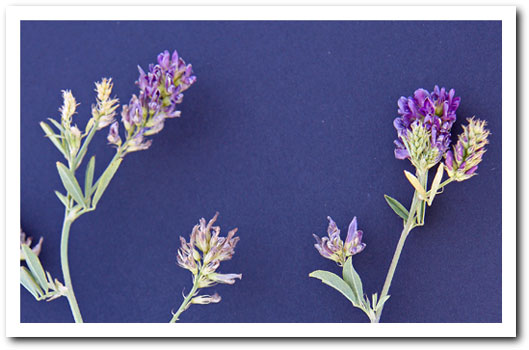Lucerne - The Least Known, Most Important Fact You Need to Know
It is a widely known fact that lucerne is high in calcium and low in phosphorous. This is why the ‘old-timers’ always fed oats when they fed lucerne because oats, being comparatively high in phosphorous, would tend to correct this imbalance.
It is also a widely known fact that lucerne is a good source of protein and can therefore be useful for feeding broodmares, growing horses and horses in intense work. However, grass in growth mode can also be high in protein so a person has to be careful not to cumulatively feed too much.
Not so widely known is the most important fact that lucerne is high in potassium and extremely low in sodium. Being a legume it stores sodium in the root nodules so there is virtually none in the above ground portion of the plant.
Apparently it is generally known in the farming community that whenever lucerne is fed to stock they should also be fed sodium (as salt)!
The trouble is nobody told the horse people! There is a lot of information out there regarding the benefits of feeding lucerne to horses but not one mention of this crucial piece of information.
This is why a lot of people have observed that lucerne ‘sends their horse nuts’! Most people’s horses are already getting an overload of potassium from the green grass they are on.
Adding lucerne, molasses, kelp, protein meals, many herbs on top of the pasture grass has a cumulative effect which creates the serious mineral imbalance talked about in other articles on this website.
High Protein Levels
When urine ‘burns’ the grass, killing it and leaving brown patches, you know the animal has ingested too much protein.
A by-product of the process of digesting protein is internal heat. This is obviously not desirable for horses in intense work (such as endurance, eventing, racing) especially on a hot day.
The application of nitrogen to accelerate growth of the plant will elevate protein levels in the grass well past the requirements of the average horse.
In this situation adding lucerne to the diet is unnecessary and potentially harmful, contributing to many problems facing horse owners such as head-flicking, laminitis, behavioural troubles, musculo-skeletal, reproductive and growth related including Developmental Orthopedic Diseases, to name but a few.
(See Dr T W Swerczek DVM Ref)
Lucerne may be useful when a horse is:
- breeding or growing
- in intense work
- grazing oxalate pastures
- Elderly horses
Remember you will need to adjust the horses sodium (as salt) intake accordingly
Most importantly look at how it will or will not fit with what else the horse is eating on a daily basis.
From a nutritional point of view, for the recreational horse owner in particular, the disadvantages out-weigh the advantages and there are other options to feed that don’t create complications.
The Photodynamic Effect
Another issue with lucerne is i ts high phyto-estrogen content. In this respect it is similar to clovers and has the potential to upset the cycling of mares and cause other reproductive problems.
ts high phyto-estrogen content. In this respect it is similar to clovers and has the potential to upset the cycling of mares and cause other reproductive problems.
Yet another issue is the fact that lucerne, like clover, is high in photodynamic (fluorescing) pigments which are the real cause of sun-burn and mud-fever.
Read : Mud-Fever & Sunburn
Read: Jane and Amigo's story which illustrates how this mineral imbalance caused major musculo-skeletal, behavioural and saddle-fitting issues
Click on: Laminitis and you will see the link between this crucial mineral imbalance and laminitis.
Click on: Head-flicking and you will see the connection to head-flicking. Lucerne is a well known ‘trigger’ for head-flicking as is clover.

Persil, pictured here at 29 years, has a diet that includes some lucerne - at his age, lucerne is a better option than chaff as chaff can cause choke if their teeth are not capable of chewing it properly.
He also gets 2 Tablespoons of salt per day in his feed along with Premium NZ Horse Minerals and ALleviateC to help balance the lucerne.
References
For more information on how potassium and nitrates affect all classes of livestock including horses:
“Grass Tetany” by Andre Voisin.
This is an easy to read e-book.
Nitrate Toxicity and Sodium Deficiency Associated with Hypomagnesemia, Hypocalcemia and the Grass tetany Syndrome in Herbivores.
Dr T W Swerczek DVM PhD
For more information on Lucerne (or Alfalfa) look up
“Poisonous Plants in the Pasture ? A Horse Owner’s Guide” CD Rom
Dr Deb Bennett Ph D
“The Making of a Champion” Feeding and Nutrition of the Horse
John Kohnke
 Calm Healthy Horses
Calm Healthy Horses